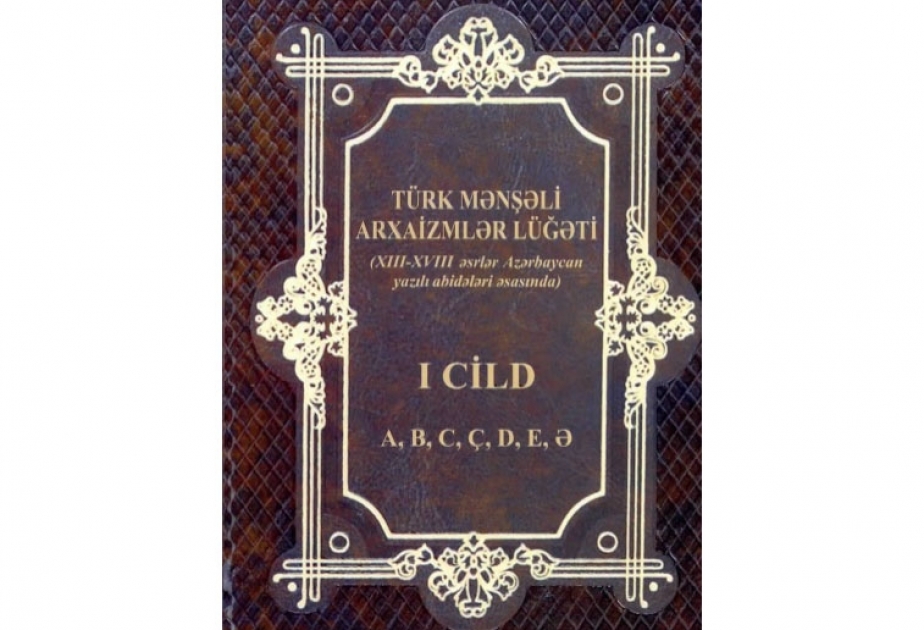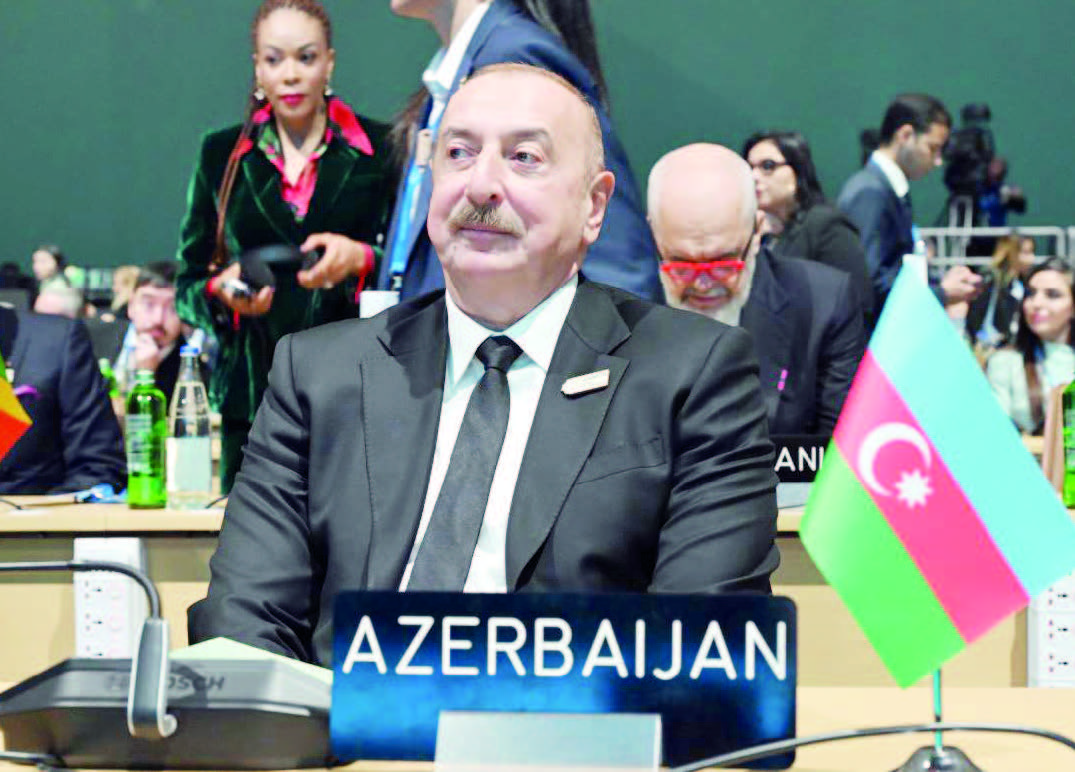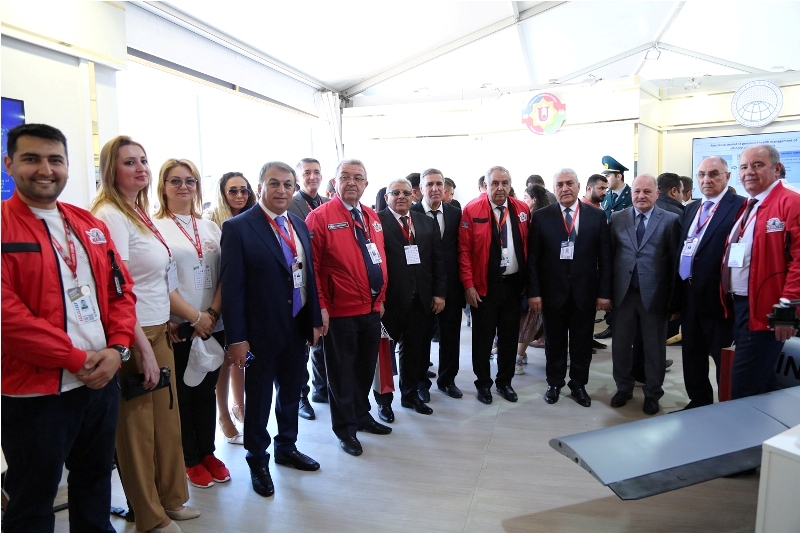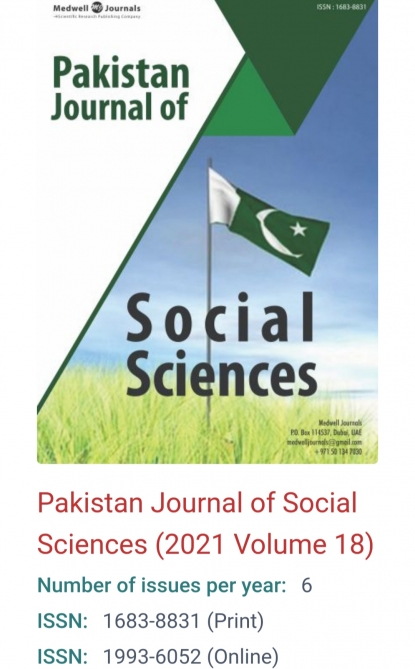
- A-
- A
- A+
First in linguistics: “Dictionary of archaisms of turkic origin” (On the basis of XIII-XVIII centuries manuscripts)
“Dictionary of archaisms of Turkic origin” is a historical dictionary of the type of diachronic philological dictionaries, which reflects the development of the semantic hierarchy of archaisms used in the written monuments of Azerbaijan in the XIII-XVIII centuries, their functionality or disuse, and the dynamics of the change of the word's form and function. In this regard, the lexicographical work presented by us is a rich source of material for the fields of lexicology, semasiology, syntax, morphology and phonetics of the history of the Azerbaijani language, and opens wide possibilities for research on specific periods. All types of archaisms (lexical, semantic, phonetic and grammatical) are included in the dictionary. The creation of a diachronic dictionary with such a non-normative character is new in the field of research on the history of the Azerbaijani language and is an indispensable resource for researchers. The compilation of the dictionary was carried out under the leadership of chief of the Department of history of the Azerbaijani Language at the Institute of Linguistics named after Nasimi of ANAS PhD, associate professor Khadija Heydarova. The staff of the department carried out this work in two stages:
1) Collecting examples from sources and arranging them in alphabetical order on the basis of key words;
2) Combining the materials collected separately by sources on the basis of the principles of the accepted compilation by letters and making them into an unique dictionary.
In the first stage, the staff of the department worked both individually and collectively on poems, epics and translated works, collecting samples of up to 60 authors and translated works. These sources are the following: the Dresden version of "The Book of Dede Korkut" , Dastani-Ahmed Harami (XIII), Ibn Muhanna's dictionary "Hilyatul-insan va halbatul-lisan" (XIII), Gul Ali's poem "Gisseyi-Yusif" (XIII), Gazi Burhanedin (XIV), Mustafa Zarir's translated works "Futuh-ush-Sham", "One hundred hadiths and one hundred stories", "Siyarun-Nabi", "Yusif and Zuleykha" (XIV), Suli Faqih (XIV), Imadaddin Nasimi (XIV), Ummi Isa's "Mehriand Vafa" (XIV), Yusif Maddah's poem "Varga and Gulshah" (XIV), Deda Omar Rovshani (XV), Afsaheddin Hidayat (XV), Ahmadi Tabrizi's translation of "Asrarnama" (XV), Shirazi's translation works "Gulshani Raz" (XV), Habibi (XV), Khalili's "Firqatnama" (XV), Khatayi Tabrizi (XV), Kishvari's Turkish "Divan" (XV), Nematullah Kishvari (XV), Sheikh Ibrahim Gulshani Bardais (XV), Haqiri Tabrizi (XVI), Muhammad Fuzuli (XVI), Ruhi Baghdadi (XVI), Shah Ismail Khatai (XVI), translated works of Muhammad bin Husayn Katib Nishati "Tazkire of Sheikh Safi" (XVI) and "Shuhadanama" (XVI), Muhammad Amani (XVII), Govsi Tabrizi (XVII) "Varga and Gulshah" by Masihi (XVII), "Qahramannama" epos (XVII), Saib Tabrizi (XVII) Molla Panah Vagif (XVIII), Molla Vali Vidadi (XVIII) , Nishat Shirvani (XVIII), Shakir Shirvani (XVIII), Mahjur Shirvani (XVIII), Arif Shirvani (XVIII), Agha Masih Shirvani (XVIII), "Sheikh Sanan" story (anonymous) (XVIII), "Duzd and Ghazi" (The thief and Gazi, XVIII), Abdurrahim Ardabili Shirvani's treatise "Mazhar ut-Turk" (XVIII).
Among them, collective work was carried out on the dictionary of Ibn Muhanna (XIII, compiled by P.P.Melioransky), "Asrarname" (XV), "Sheikh Safi Tazkire", Muhammad Amani (XVI-XVII), "Selections from the classical literature of Azerbaijan" volumes II and III. Other sources cited were worked out by the following collaborators:
1. Gul Ali's poem "Gisseyi-Yusif" (XIII), translated works "Shuhadanama" (XVI) and "Qahramannama" (XVII), Abdurrahim Ardabil Shirvani's treatise "Mazhar ut-Turki" (XVIII) – by the chief of the department of the history of the Azerbaijani language, Ph.D., Assos. Prof.Khadija Heydarova;
2. "Dastani-Ahmed Harami" (XIII) and "Mehri and Vafa" (XIV) by Ummi Isa – by senior researcher, Honored Scientist, Doctor of sciences in philology, prof. Gazanfar Kazimov;
3. Imadaddin Nasimi (XIV) – by senior researcher, Doctor of sciences in philology, prof. Sevil Mehdiyeva;
4. "The Book of Dede-Korkut" epic – by senior researcher, Ph.D., Assos.Prof. Vahid Adilov;
5. Masihini's work "Varga and Gulshah" (XVII) and ghazals of Govsi Tabrizi (XVII) – by leading researcher, Ph.D. Assos.Prof. Teyyub Guliyev;
6. Mustafa Zarir's work "Futuh-ush-Sham" (XIV) – by leading researcher, Ph.D., Assos. Prof. Vahida Jafarzade;
7. Khatayi Tabrizi (XV), Shah Ismail Khatayi (XVI), Habibi (XV), Haqiri Tabrizi (XV), Sheikh Ibrahim Gulshani Bardai (XV), Kishvari (XV), Yusif Maddah's poem "Varga and Gulshah" (XIV) – by leading researcher, Ph.D. Reyhan Madatova;
8. The works of Sheikh Ibrahim Gulshani Bardai (XV), Dede Omar Rovshani (XV), Kishvari (XV), Khalili's "Firqatnama" (XV), Khatayi Tabriz's "Yusif and Zuleykha" (XV), Afsaheddin Hidayat's "Divan" (XV), Habibi (XV) - by leading researcher, Ph.D., Assos. Prof.Aynur Pashayeva;
9. "Duzd and Gazi" (XVIII), Nishat Shirvani (XVIII), Shakir Shirvani (XVIII), Mahjur Shirvani (XVIII), Arif Shirvani (XVIII), Agha Masih Shirvani (XVIII) – by senior researcher, Ph.D., Aynur Mahmud.
10. Muhammad Fuzuli (XVI) – by leading researcher, Ph.D., Assos.Prof.Turkan Asgarova;
11. Sheikh Sanan (XVIII), Molla Panah Vagif (XVIII) and Molla Vali Vidadi (XVIII) – by senior researcher, Ph.D. Elnura Abbasova;
12. Mustafa Zarir's "One Hundred Hadiths and One Hundred Stories" (XIV), "Yusif and Zuleykha" (XIV) and Gazi Burhaneddin's "Divan" (XIV) - by senior researcher Rakhshana Babazadeh;
13. Shirazi's "Gulshani-raz" (XV) and Mustafa Zariri's "Siyarun-Nabi" (XIV) – by researcher Vasila Khalilova.
In the second stage, the following principles were observed when the illustrative materials selected from all these works were combined by the employees in alphabetical order by letter:
a) creating a dictionary article for each archaism;
b) referring to the manuscripts by making reconciliations in front of each main word to give it in the old Azerbaijani script;
c) determining the meaning development of homonyms and polysemy words and dividing them into clauses;
d) providing examples in chronological order and enriching the gaps that appear in this order with additional materials;
e) clarifying the explanations and etymology of archaisms;
f) comparison of phonetic archaisms in alphabetical order.
At this stage, the employees have been assigned the following letters:
1. Letters A, B, C, Ç, Q have been assigned to chief of department, Ph.D., Assos. Prof. Khadija Heydarova;
2. Letters D, E, Ə have been assigned to leading researcher, Ph.D., Assos. Prof. Teyyub Guliyev;
3. Letters G, H, X, I, İ have been assigned to leading researcher, Ph.D. Reyhan Madatova;
4. Letters K, L, M have been assigned to leading researcher, Ph.D., Assos. Prof. Aynur Pashayeva;
5. Letters N, O, Ö, P have been assigned to leading researcher, Ph.D., Assos. Prof. Askerova Turkan;
6. Letters S, Ş, T have been assigned to senior researcher, Ph.D. Elnura Abbasova;
7. Letters U, Ü, V, Y have been assigned to senior researcher, Ph.D. Aynur Mahmud.
The first volume of the presented lexicographic work includes 7 letters: A, B, C, Ç, D, E, Ə. The first four of them were compiled by the chief of the department, Ph.D., Assos. Prof. Khadija Heydarova, and the next three by the leading researcher, Ph.D., Assos. Prof.by Teyyub Guliyev.
It is necessary to mention the names of the employees of the department who were active in the editing process of the first volume: Doctor of sciences in philology, prof. Sevil Mehdiyeva, Ph.D., Assos.Prof. Vahida Jafarzadeh, Ph.D., Assos.Prof. Teyyub Guliyev. At the same time, I would like to express our gratitude to Rakhshana Babazadeh, a senior researcher who, although not from this department, participated in the project, did her best and was exemplary with her honest work.
When arranging the quotations in the “Dictionary of archaic Turkic Origin”, searches were conducted in each of the aforementioned sources to clarify in which periods they were developed. For instance, the phonetic archaism of the word ağrığ is found in Ibn Muhanna's dictionary, a XIII-century monument, and the latest “Sheikh Safi” tazkira, which dates back to the XVI century. After the XVI century, the phonetic variant in question was no longer in use. It is worth noting that lexical archaism was first observed in the XIV century in “Futuh-ush-Sham” and finally in the translated works “Sheikh Safi” and “Shuhadanama” in the XVI century. While these studies are based on up to 60 sources, their accuracy cannot be guaranteed. It is possible that the archaisms that were not found during the period searches may have appeared in other works that are not included in the sources of the “Dictionary of archaisms of Turkic origin”. If this is the case, informing the staff compiling the dictionary will be of great benefit for future improvements.
In general, “The Book of Dede-Korkut” epic takes place first in chronological order, followed by the monuments of the XIII century and others. To provide samples from these monuments, it is necessary to identify the archaisms sought after.
The “Dictionary of archaisms of Turkic origin” clearly shows the development of meaning and the intensity of word processing. It is common for some words to be found only in the language of one author, while others are present in all works. For instance, the verb bulmaq, which is considered archaic in modern language, was widely used in both poetry and prose until the XVIII century.
Regarding sources, we had to decide whether to include Ibn Muhanna's dictionary in our own. It was challenging to use because the dictionary section of his Istanbul copy was organized thematically. The alphabetical translation of this copy by Abdulla Battal is flawed due to both phonetic inaccuracies (it does not reflect Azerbaijani Turkish) and the mismatch of some pages in the source. At the end of P.M.Melioransky's doctoral dissertation, which was published in 1900, five European copies were collected and presented in alphabetical order. Therefore, priority had to be given to him.
Explanatory dictionaries that reflect modern language should provide the true meaning of the main word during semantic division, rather than the first meaning. Historical dictionaries should prioritize the oldest and most commonly used meaning in their articles. Our “Dictionary of archaic Turkic origin” provides explanations and classifications based solely on the context of quotations and reliable dictionaries.
We have excluded words starting with the letters F, J, and R from the modern Azerbaijani alphabet and lexicon as they were not developed in our ancient language. Therefore, they are not included in our dictionary. Words beginning with the consonant H are not characteristic of ancient Turkish language. However, archaisms such as handa, hanğı, hayğırmaq, hayıfsınmaq, heylə/helə/hillə, həp etc. are used in medieval written monuments and are planned to be included in the second volume of the dictionary.
As there were no uniform orthographic norms in the Middle Ages, we based the texts in the dictionary with the old Arabic alphabet on ancient manuscripts. According to Samet Alizade, while the sound of ng or naf is common to Turkic languages, its graphic expression varied in individual Turkic writings (written monuments). Until the XV century, the sound represented by the letter kāf, or by kāf with three dots below or above it, was occasionally written as kāf with a sarkesh (ك) and hamza at the end of the word. Since the XVI century, the digraph نك has become the standard representation of the ng sound in written Azerbaijani. The nastaliq style is responsible for introducing the same letter combination to the written sources of Azerbaijan and Central Asia. This combination was formed after the appearance of the line of descent in our old writing cultures. It is noteworthy that the digraph نك was the primary graphic and orthographic sign that differentiated our written language from the Turkish (Ottoman) written language in the XVI and XVII centuries. The uniqueness and independent history of the written literary language of Azerbaijan in the Middle Ages is of great importance.
In the sources used in the dictionary, this variant was accepted for the spelling of the main word with the old alphabet, as ng is mostly represented with kāf (ک). The letter kāf also represented the sounds g and k. However, in Ibn Muhanna's dictionary, a monument of the XIII century, three dots (ڮ) were specifically applied for the g sound. We have used that symbol in the examples of the mentioned dictionary to preserve its originality. Here, three dots (نڮ) are observed under the letters ng and kāf to express the diphthong ng. This same situation can be observed in the manuscript of Gazi Burhanedin. However, in that manuscript, the dots are written on the kāf (ݣ). The same is given in the dictionary.
Additionally, due to the lack of a common literary language and orthographic norms in the Middle Ages, and the inability of the old Arabic script to accurately express vowel sounds, errors in transphonemic literacy have occurred in the modern era. For this reason, the dictionary aims to include all phonetic variants of words observed in written monuments of Azerbaijan. For example, the verb aymaq means “to say” or “to tell” and has variants such as ayıdmaq, ayıtmaq, aytmaq, etmək, eytmək, and əytmək. Similarly, there are phonetic and syntactic variants such as aydı vermək, edü vermək, eyidi vermək, eydi vermək, and eydü vermək. An example of the phonetic variants of the verb üşətmək / uşatmaq, meaning to break, can be provided. It is important to note that these words are separated in alphabetical order in the dictionary and are therefore compared to each other.
Another important point in our dictionary is the interpretation of archaic morphological features for users. For example, -ısar/-isər, -daçı/-dəçi və -ğay/-gay future tense suffixes, van/-vən first person singular indicative suffix, ancient Oghuz suffix -duq/-dük can be used in place of both definite and subjunctive past tense verbs, -ıban(ı)/-iğan(i) past participle suffix and so on.
Finally, the department would like to express gratitude to professor Nadir Mammadli, the general director of our institute and the editor-in-chief of the dictionary, for his patronage and assistance in creating and printing this lexicographic work.
It is hoped that this dictionary will be of lasting value and become a reference book for researchers.
Khadija HEYDAROVA, Institute of Linguistics named after Nasimi of ANAS Chief of department of the history the Azerbaijani language, Ph.D. in philology, Associate Professor
©All rights reserved. When using news www.science.gov.az a reference to the site is necessary.

 Elm TV
Elm TV
 Photo
Photo
 Video
Video



